Results 41 to 50 of 52
Thread: What is a hybrid coticule?
-
09-23-2011, 08:19 PM #41
-
09-25-2011, 05:51 PM #42Senior Member

- Join Date
- Apr 2010
- Location
- Central MA
- Posts
- 118
Thanked: 19
IME, the 'hybrid' is essentially a thin, mixed zone of the yellow (coti) material and the underlying BBW (slate/shale...). Coticules are formed - more or less - from volcanic ejecta that was deposited on Mn-bearing clayey sediments on the sea floor. After the oceans receded or uplift exposed these rocks, they were basically 'cooked' by pressure (and/or heat) which altered the rock characteristics and mineralogy (e.g., forming high-Mn garnets of very small particle size). The clayey layers (BBW) represent periods of stability which alternated through time with more violent periods of episodic deposition of volcanic material. Hence the abrupt boundary commonly seen between the coti and BBW layers. This cycle repeated over time and is responsible, in part, for what we think of as the different coticule layers.
Where the coti (volcanic) layers were deposited only for a short time (thin) and/or later eroded or reworked (e.g., during the 'cooking'), you can wind up with a thin, mixed zone near the contact of coti with BBW that looks to me like what has been described as a 'hybrid'.
My guess is that hybrids were simply viewed as 'rejects' and overlooked for years because the market demanded nice traditional-looking hones with thick coti layers over BBW. Now, they are all-of-a-sudden in great demand because whackos like us figured that they look really cool and may in fact have some interesting properties. Whodathunkit?
Last edited by Woodash; 09-25-2011 at 05:54 PM.
-
09-25-2011, 05:57 PM #43

When I first read about the hybrid layer, I thought the exact same thing. But after playing with for awhile, I'm not so sure. The BBW layer laps and slurries easily. Most varieties of coticule lap easily and while it slurries on varies levels, it will still slurry. The hybrid layer doesn't lap easily, not does it slurry. It is a much harder (not denser) layer than the coticule or BBW.
-
09-25-2011, 06:27 PM #44Senior Member

- Join Date
- Apr 2010
- Location
- Central MA
- Posts
- 118
Thanked: 19
^ I seriously doubt that the hybrid represents any kind of 'new' material. It's possible that different alteration processes on materials of varying layer thickness could have had effects on cementation, compaction/density, etc.
-
12-30-2011, 11:17 PM #45Member

- Join Date
- Jul 2007
- Location
- The Nederlands
- Posts
- 65
Thanked: 6
Hey Guys,
I finally got to lapping my "dirty" coticule, had it for a while and I was under the impression that the previous owner neglected it for a long time. I couldn't have been more wrong.
I apoligise for the pictures I had nothing else than my camera phone.
First picture I'm lapping the dirty coticule (almost done) it does get lighter but nowhere near a normal coti (one in the left). Notice the white slurry on the DMT from the dark coti.
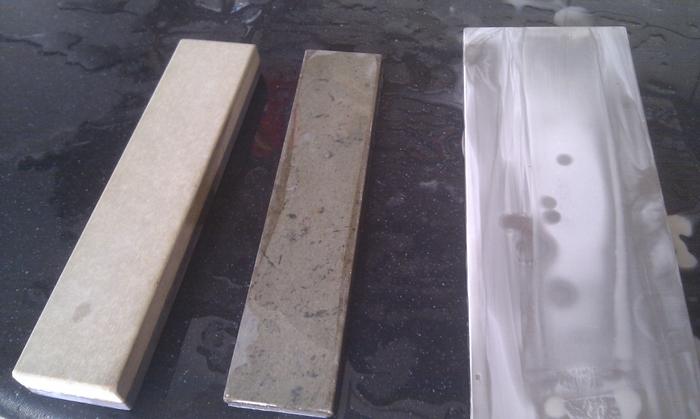
The normal coti next to the other one.
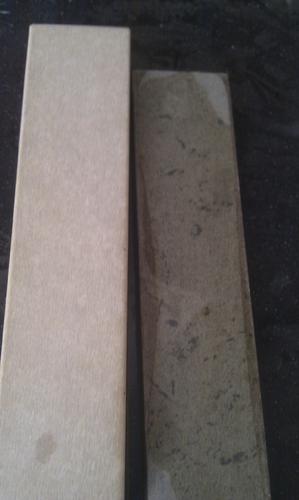
Close up of the normal coti, you can see the usual fractured patern.
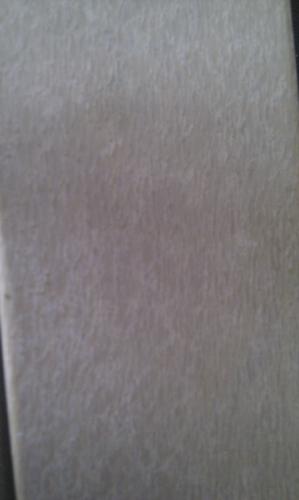
Close up of the dark coticule. (with flash) same fractured patern.
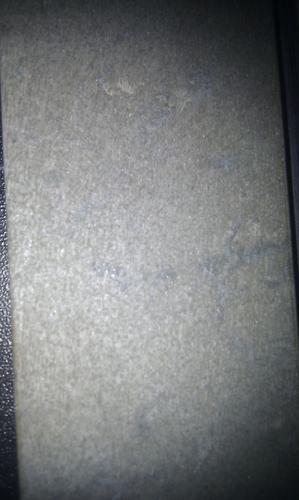
Close up of the dark coticule. (without flash)
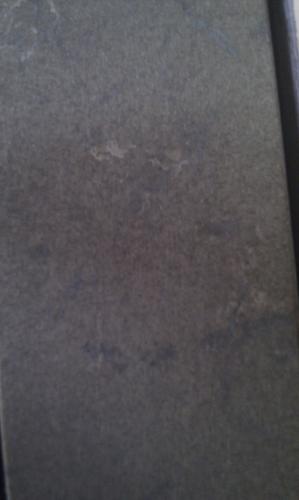
I honed a razor with it and it is similar to the normal coti's, nice and smooth but less smooth than the other dark coticule.
Hope you like the pictures and if there are any questions, fire away!
Just to cover the ovious question: She isn't for sale!
-
12-31-2011, 06:45 PM #46'tis but a scratch!



- Join Date
- Oct 2010
- Location
- Durango, Colorado
- Posts
- 2,080
- Blog Entries
- 2
Thanked: 443
-
02-17-2012, 08:32 AM #47Member

- Join Date
- Feb 2012
- Posts
- 41
Thanked: 10 I think the guy that thought they were regarded as rejects is closest to the truth
I think the guy that thought they were regarded as rejects is closest to the truth
I have always regarded what you folks seem to call hybrids as simply poor quality coticules. I think pretty much everyone did until somebody figured out how to make extra money on them by calling them hybrids. What limited knowledge I have of the Belgian stones has always led me to believe that the cleaner the yellow tan cream of the coticule section, the better quality the stone. Nothing in my small collections of coticules has led me to think any different. Any stone imbedded in the yellow coticule HAS to be inferior just by the very nature of the coticule veins. There is no stone harvested in these mines that has superior sharpening properties to the yellow coticule and that is the way the mines priced and sold them for decades.
The 8 x 3 coticule I bought from Howard a few years back has some black streaks that appear at times as the stone wears down, but that isn't a good thing. Dark lines running through the stones are imperfections and at best do nothing but at the worst hinder getting a sharp edge as the dark stone isn't coticule but a lesser quality stone. At least this is what I believe makes the most sense and has been my experience.
-
02-17-2012, 09:49 AM #48
-
02-17-2012, 02:35 PM #49

I haven't found the black lines (or for that matter, orange, red or brown lines) to affect the honing on the coticules that I have used. They can not be felt either when honing or touching the razor. To my knowledge they are deposits of manganese which are not the same as inclusions, the latter which can affect the properties of a stone in some cases.
Of course, there is no direct comparison between one coticule with them and another without in terms of the difference that the lines themselves make as the coticules themselves have different properties, however I can advise that I have had a coticule with lines that was superior to another without.
Regarding the 'hybrids' I have no opinion, as I have never used one, neither am I going to spend the requisite funds just to test one. I doubt they will improve on my Escher so I can live without them.
-
02-17-2012, 04:52 PM #50

There is no doubt that the hybrid stones, known as les latneuses, for the vein from which they are/were harvested, were not saleable because of cosmetic "flaws." Like the BBW, the les lat was the 'red headed step child' and was pushed to the side for decades. Again , like the bbw, some enterprising soul took a blade to the 'hybrid' side and found they are an effective hone. The proof of the pudding is in the eating and these hybrid les lats deliver the goods, according to reports from happy users.
Twenty five or thirty years ago I bought a few coticules from three different barbers in north New Jersey. All three told me the yellow side, not the bbw, was the honing surface. The bbw was only there to support the fragile yellow. This was the consensus back then. Matter of fact, Old Rock and Deep Rock branded coticules have the labels glued onto the bbw, which is further evidence that at that time the bbw wasn't considered a hone at all. Maybe necessity became the mother of invention, one way or another, it was discovered that the bbw is a pretty good hone. Not on a level with the yellow coticule but it is usable.
In addition, I've had vintage cotiucles with manganese dots and stripes running in and through the yellow on the surface. A Salam labeled coticule I had was heavily marked with the manganese. As long as the additional material is not harder than the yellow, and doesn't interfere with the honing it is only a matter of cosmetics. Ardennes Coticule stepped in doo doo when a coticule enthusiast publicised this 'new' found hone, the hybrid. I had one vintage, when I say vintage I mean a commercially harvested and sold coticule from way back, that was pink on the coticule side and had the gray/mottled colors of the les lat hybrid. Very hard and a beast to lap. I played with it a bit and it seemed to polish the edge but I sold it before I came to any firm conclusion. Anyhow, AFAIC, these les lat hybrids are viable hones. As to whether they are worth what they are getting for them, that is for the end user to decide.
BTW; Stepped in doo doo, is an old USA expression from my region, that means "got lucky"
Last edited by JimmyHAD; 02-17-2012 at 04:56 PM.
Be careful how you treat people on your way up, you may meet them again on your way back down.


 38Likes
38Likes LinkBack URL
LinkBack URL About LinkBacks
About LinkBacks








 Reply With Quote
Reply With Quote